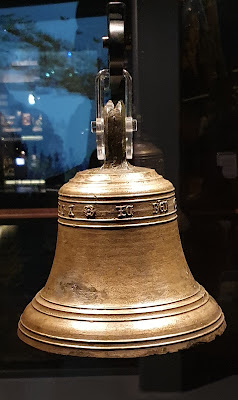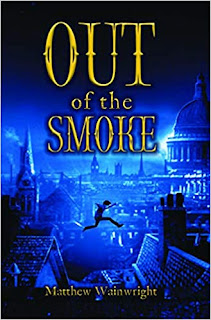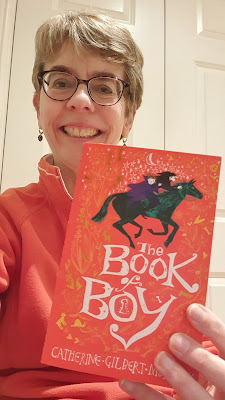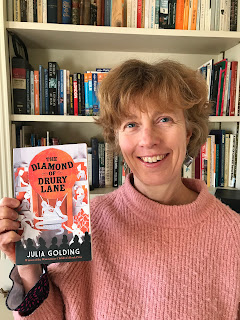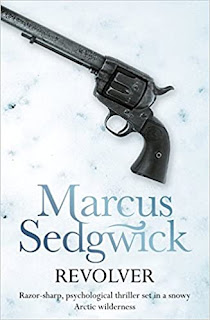My grandad – born into a working-class family in late Victorian England – led an eventful life. Sadly, I never got to hear about it first-hand as he died of ill-health brought on by his experiences as a gunner for the Royal Field Artillery in the First World War, 15 years before I was born. But one of the many stories my dad told us about him was that he had been born in a workhouse in Camberwell, south London. More recent research into our family tree has revealed that several of our other ancestors also spent time in workhouses during the course of their lives.
Workhouse record showing names of my grandad and great-grandmother
I remember learning something about the workhouse system and why it came into being in history lessons on the Industrial Revolution at school. First created through the enactment of the New Poor Law in 1834, three years before Queen Victoria came to the throne, it replaced the earlier ramshackle system of assistance or ‘poor relief’ for those who couldn’t work due to age or disability, in operation since Elizabethan times.
Under the law, a network of hundreds of specially designed institutions were set up to give shelter to the poorest and most vulnerable in society. Commonly referred to as ‘paupers’ or ‘the destitute’, these were people who couldn’t afford to feed or clothe themselves and who would otherwise have ended up living, and in many cases dying, on the streets – forced to beg or else turn to a life of crime to support themselves. They included the unemployed, the elderly, unmarried mothers, women whose husbands had deserted them and people with physical or mental disabilities. In the absence of unemployment benefit, state pensions and the health and social care provided by the modern welfare state, unless they were granted money or help to continue living at home – ‘out-relief’ – the workhouse was their only recourse.
Workhouses were a contradictory blend of things. On the one hand they were designed to provide much needed support in the form of food, clothes and a roof over the head to those unable to look after themselves. But through their policy of separating families – wives from husbands, parents from children – and the heavily-supervised regime of dull routine and gruelling manual labour able-bodied inmates were expected to undertake – they were also intended to act as deterrents, discouraging people from regarding them as an alternative to employment and pushing them instead to do all they could to fend for themselves.
Institutions were run by a Governor, or Master, and a Matron who was responsible for overseeing the women and children and ensuring the provision of nursing care. They reported to a committee of unpaid Guardians, elected by each parish from amongst local ratepayers, whose taxes funded the workhouse. Regional Inspectors would visit the workhouses on their patch to check they were abiding by the rules set out under the New Poor Law. Though many were well-run, there were sadly also examples of inmates, like poor Oliver Twist and his friends in CharlesDickens’ novel of the same name, being badly treated and insufficiently fed, plus instances of staff corruption too. A combination of factors – the general stigma associated with having to go into a workhouse in the first place, the loss of independence and tough conditions once inside, and stories of harsh treatment and brutality – meant that most people regarded them as a place of last resort, to be avoided at all costs.
Family ancestry research has revealed that like Oliver Twist, my grandad was born in a workhouse to an unmarried mother – my great-grandmother – who was admitted when she was in labour at the age of 17 years. In late Victorian England, to fall pregnant when you were unmarried was frowned upon and meant that you risked being cast out into the world by your family with no means of support. My great-grandmother’s own mother had died when she was tiny, and for her, it seems that seeking admission to the workhouse infirmary to give birth was probably the only real option to get the help and care she needed. The records suggest that she was in the workhouse for less than a month and then left – presumably with my grandad. We don't know where they went after. Perhaps back to the family. But if they had stayed longer, what would life have been like for them as inmates? Last summer I had the chance to find out on a visit to an incredible survivor from those times.
Southwell Workhouse in Nottinghamshire, now in the care of the National Trust, is one of
the earliest and most complete examples of a 19th century workhouse
to survive in the country. Largely unaltered from its original construction in
1824, it provided the prototype for all other workhouses under the New Poor Law
system.
Visitors
today can explore all aspects of workhouse life from the work rooms, exercise
yards and dormitories used by the inmates, to the infirmary – where the sick
were cared for and women, like my great-grandmother gave birth – and staff quarters.
I could easily write a whole series of blogs on what I discovered on my visit,
but as space is tight, here are just a few insights into what it was like to be
a child inmate.
You may be admitted with your parents after they sought financial help from the parish, or else as an orphan or because you’d been abandoned – a sad reality for many children born into poverty in those days. Or maybe, like my grandad, you ended up being born there because your mother couldn’t get medical attention or support anywhere else. On admission, your clothes and any other belongings you might have with you would be confiscated, fumigated and stored away to be returned to you when you were eventually discharged. In their place you were given a workhouse uniform, usually made of coarse blue cloth.
Kept
apart and
sorted out
If you
were admitted with siblings, you might be allowed to stay together, depending
on your age. But if arriving with your parents, you would be separated from
them since all able-bodied adults capable of work but who weren’t in a job (known
in Victorian times as the ‘undeserving poor’) were regarded as a bad influence,
including on their own offspring!
Your parents
could request to see you, on a fixed day of the week, and always under the
supervision of the Master or Matron in charge.
Like the
adult inmates, children were divided into classes. These were:
·
Boys
aged 7-12 years (later 7-15 years)
·
Girls
aged 7-15 years
·
Children
under 7
A strict timetable
Just as
for the adults, you would be expected to follow a strict timetable. You would
get up with the rising bell (6am in the summer, an hour later in winter), put
on your uniform, get washed, make your bed and empty your chamber pot. Prayers
and breakfast would be followed by lessons in the classroom. Dinner was served at
12 noon with time for recreation followed by work-related training in the
afternoon. This was followed by supper at 6pm with a little more time for
recreation, then prayers and bed at 8pm. Sunday was a day of rest as were Good
Friday and Christmas Day.
Reading,
writing and arithmetic
As a child
inmate you had one advantage over other working-class children in the early
days of the workhouse system at least, receiving a basic formal education long
before it became compulsory in wider society. If you were under seven, you
would be taught in mixed classes. If older, you would find yourself in a class
of either boys or girls taught by a school master or mistress. The main
subjects, taught for three hours each morning, were basic arithmetic, reading
and writing with religious instruction given by a chaplain.
In the
afternoon, you could expect to be given ‘industrial training’ – most likely gardening
for the boys and needlework, cookery or working in the laundry for the girls.
In this way, the thinking went, you would
be better equipped on leaving to find employment, whether in domestic service
or working in a factory or on the land. And the authorities hoped, less likely to end up back inside the
workhouse again.
Food, but not so glorious …
Breakfast
was a simple meal of bread and gruel – a type of thin porridge.
Dinner –
the lunchtime meal – was usually made up of boiled meat, peas and potatoes or
else soup or suet pudding with portions carefully weighed out according to the
age category of the child – so the youngest children got the smallest amount of
food.
Supper was
a repeat of breakfast – with bread and more of that tasty gruel!
This sort
of fare might sound boring by our modern standards but, provided the workhouse
was well run and the inmates were given what they were entitled to, it was a
reasonably well-balanced diet, though perhaps a little lacking in Vitamin C.
The only
variation in the menu was on Christmas Day when you could look forward to a
meal of roast beef and plum pudding.
The end of the workhouse
The Poor
Law was brought to an end in 1929 and workhouses – now known as ‘institutions’
– passed into the care of local authorities. Any children remaining in them
were moved to specialist homes though unfortunately this meant they often saw
their parents even less than they had before. Things changed again with the
introduction of the Welfare State in 1948 and many former workhouses became
state hospitals in the new National Health Service.
As for the
workhouse infirmary in Camberwell my grandad was born in, it is now a smart-looking residential
apartment block, something he would find hard to conceive of I’m sure.
Workhouse stories
Besides
Charles Dickens’ Oliver Twist, the experience of children in workhouses
has also been brought to life by a number of brilliant children’s authors writing in more
recent times. Two of my favourites are:
Street Child by Berlie
Doherty about a young boy called Jim Jarvis who is carted off to the workhouse
with his sick mother. After her tragic death, Jim escapes and ends up in
further peril on the streets of Victorian London.
TheTwisted Threads of Polly Freeman
by Pippa Goodhart which charts the life of a young girl called Polly, sent to a
London workhouse after she and her ‘Aunt’ – a thief – are evicted and made
homeless. From there it follows Polly on a journey to Quarry Bank Cotton Mill
in Cheshire where she is sent to become a mill-girl apprentice.
Writing Challenge
Imagine you have been forced to enter the
workhouse for the first time. Ask yourself these questions:
Why did you have to go there?
Have you come in with your parents? What do
you feel about being separated from them if you have? And what about your brothers
and sisters?
What are your first impressions of the place?
Think about things like the strict rules and routines; the lack of privacy and having
to share sleeping quarters; the sort of food you’re given to eat. What do you
make of having to go to school? Perhaps it’s for the first time? And what sort
of work are you given to do in the afternoons? Are the Master and Matron kind
to you, or do they make things a whole lot worse like they did in Oliver
Twist?
Do you miss your life outside the workhouse,
even though it must have been hard. And do think you might try and run away? Or
is it better to stay where you’ll have a roof over your head, food to eat and the
chance to learn how to read and write?
Write your thoughts down, then have a go a turning
them into the start of a story, a diary or perhaps a comic strip. Happy writing!
Source material for information on the New Poor Law and life in a workhouse comes from 'The Workhouse Southwell' Guidebook published by National Trust.
Ally Sherrick is the award-winning author of stories full of history, mystery and adventure.
BLACK POWDER, her debut novel about a boy caught up in the Gunpowder Plot, won the Historical Association’s Young Quills Award. Other titles include THE BURIED CROWN, a wartime tale with a whiff of Anglo-Saxon myth and magic and THE QUEEN’S FOOL, a story of treachery and treason set at the court of King Henry VIII. Ally’s latest book with Chicken House Books, is VITA AND THE GLADIATOR, the story of a young girl’s fight for justice in the high-stakes world of London’s gladiatorial arena. It has been shortlisted for a Young Quills Award.
For more information about Ally and her books
visit www.allysherrick.com You can also
follow her on Twitter @ally_sherrick















